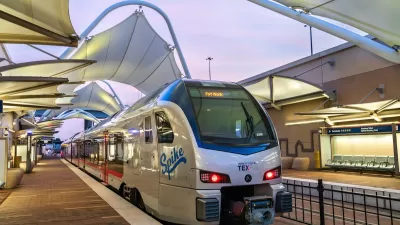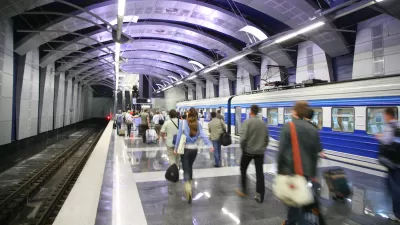Should the tolls you pay to traverse a bridge or highway go directly to the upkeep of that roadway, or should they go to fund transportation projects, such as public transit? Five experts debate this question in the New York Times Opinion Pages.
With cash-strapped states raiding toll revenues in their search for funding sources for a range of transportation projects, Sam Staley, economic development policy analyst with the DeVoe L. Moore Center at Florida State University and the Reason Foundation, argues against "robbing Peter to pay Paul," because he believes "[d]iverting toll revenue reduces transparency and undermines public confidence over the long run."
Todd Litman, executive director of the Victoria Transport Policy Institute in British Columbia, delivers the counter-argument, that due to shifting demographic and economic trends, and the "uncompensated costs" of vehicle traffic, "it makes sense to shift money and road space away from
automobile use and toward alternatives, like walking, cycling and public
transportation, particularly in large urban areas where vehicle traffic
imposes significant congestion, accident and pollution costs."
Other viewpoints are offered by Lexer Quamie, policy counsel for the Leadership Conference on Civil and Human Rights; Edward Rendell, former governor of Pennsylvania and mayor of Philadelphia; and C.W. Marsella, former general manager and chief executive of the Denver Regional Transportation District.
FULL STORY: You Pay the Toll. Where Should That Money Go?

Manufactured Crisis: Losing the Nation’s Largest Source of Unsubsidized Affordable Housing
Manufactured housing communities have long been an affordable housing option for millions of people living in the U.S., but that affordability is disappearing rapidly. How did we get here?

Americans May Be Stuck — But Why?
Americans are moving a lot less than they once did, and that is a problem. While Yoni Applebaum, in his highly-publicized article Stuck, gets the reasons badly wrong, it's still important to ask: why are we moving so much less than before?

Using Old Oil and Gas Wells for Green Energy Storage
Penn State researchers have found that repurposing abandoned oil and gas wells for geothermal-assisted compressed-air energy storage can boost efficiency, reduce environmental risks, and support clean energy and job transitions.

Updating LA’s Tree Rules Could Bring More Shade to Underserved Neighborhoods
A new USC study finds that relaxing Los Angeles’ outdated tree planting guidelines could significantly expand urban tree canopy and reduce shade disparities in lower-income neighborhoods, though infrastructure investments are also needed.

California's Canal Solar Projects Aim to Conserve Resources and Expand Clean Energy
California’s Project Nexus has begun generating electricity from solar panels installed over irrigation canals, with researchers and state agencies exploring statewide expansion to conserve water and boost clean energy production.

HHS Staff Cuts Gut Energy Assistance Program
The full staff of a federal program that distributes heating and cooling assistance for low-income families was laid off, jeopardizing the program’s operations.
Urban Design for Planners 1: Software Tools
This six-course series explores essential urban design concepts using open source software and equips planners with the tools they need to participate fully in the urban design process.
Planning for Universal Design
Learn the tools for implementing Universal Design in planning regulations.
Heyer Gruel & Associates PA
City of Moreno Valley
Institute for Housing and Urban Development Studies (IHS)
City of Grandview
Harvard GSD Executive Education
Salt Lake City
NYU Wagner Graduate School of Public Service
City of Cambridge, Maryland





























